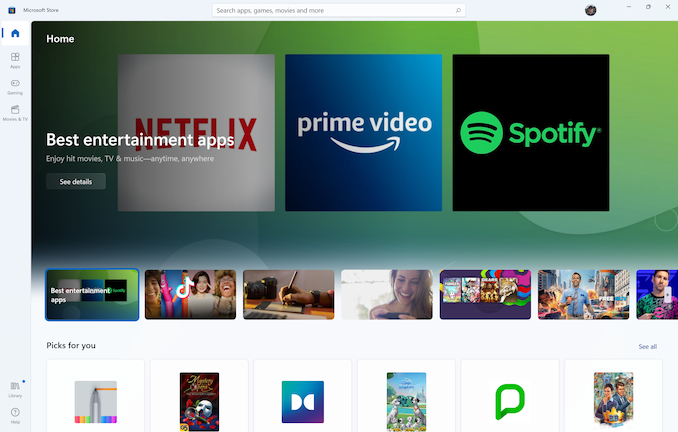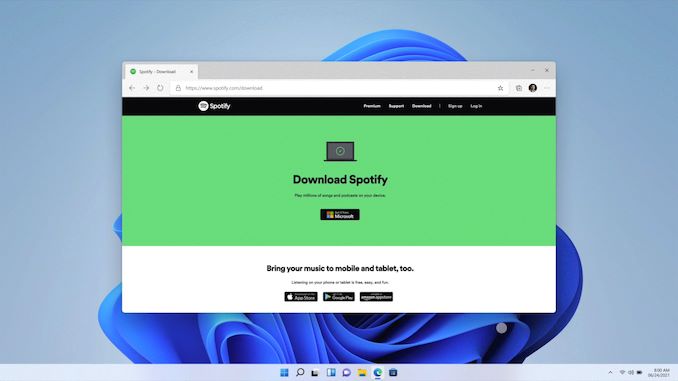What to Expect with Windows 11: A Day One Hands-On
by Brett Howse on October 4, 2021 4:00 PM EST- Posted in
- Software
- Operating Systems
- Windows
- Microsoft
- Windows 11
Microsoft Store
There are some big changes to the Microsoft Store model, although not all of them will be available at launch. Microsoft is dramatically changing their policies on what can go in the store, which should open the store up to more applications. Unlike the user interface changes though, the new store features/policies will be applied to Windows 10 as well.
When the Microsoft Store first appeared in Windows, it forced developers to utilize what eventually became known as Universal Windows Platform applications, or UWP apps. That nomenclature has morphed over time, and eventually Microsoft created methods for developers to publish more traditional Win32 applications in the store as well. The Windows 11 store dramatically expands this, allowing developers to publish any application built in any framework. Win32, .NET, UWP, Xamarin, Electron. React Native, Java, and of course Progressive Web Apps are now all supported frameworks in the store. This should immediately make the store much more useful to all users.
Microsoft is also changing the revenue share that they take from developers, perhaps inspired by some of the angst and anger directed at Apple’s App Store. The revenue share is now 85/15 for the developer for applications, and 88/12 for games. What’s more, if application developers bring their own e-commerce platform to their applications, whether one that is in-house or a third party one, Microsoft will take none of the revenue. In addition, Microsoft will be allowing stores within their store, so for example, Epic Games will be available through the Microsoft Store, but Microsoft will not take any of the revenue from Epic for any games sold. The only exception to these rules are video games distributed through the store – game developers will have to give Microsoft a cut regardless, which is perhaps not too surprising given that games are the single largest source of revenue on any of the app store platforms.
Overall, these are dramatic changes and should help the Microsoft Store be a place where people can actually find the apps they want and need. Which not only simplifies the install for the user, but provides a safety net compared to installing random software off the internet.
To be fair, Microsoft is not making these changes because they are a kind, generous company. They are making these changes to try to help the Microsoft Store compete. If applications do not show up in the store now, there seems to be little more they will be able to do to convince developers.
Android Apps on Windows
One of the biggest announcements for Windows 11 is Android application support, and Microsoft will be partnering with the Amazon App store to provide these applications. The underlying technology to support Android applications will be very similar to the Windows Subsystem for Linux, and will be called the Windows Subsystem for Android.
This is another key play for Microsoft to expand Windows 11 and bring additional functionality. Although Microsoft has supported tablet-style applications in Windows since Windows 8, they have never achieved very much developer support. That being said, Android tablet applications have never taken off in a way that most would have expected – Android tablets are predominantly used as portable TVs, as opposed to productivity devices – so we will have to wait and see if this is as big of a deal as promised.
The bad news is that, like many of the promised features for Windows 11, this is not available on launch day, and is scheduled to be available some time in 2022.
Install Apps from the Web
To simplify the experience, Microsoft will also be supporting a simplified install via pop-up on the web for sites that have apps in the store. This is something that other operating systems already support, but still nice to see.













95 Comments
View All Comments
Gigaplex - Monday, October 4, 2021 - link
I've been using Windows 11 for a while now on my HTPC. Running on a 4K screen from several metres away, I have to use 200% UI scaling for the text to be readable. No big deal, right? Turns out the Start Menu doesn't seem to support UI scaling properly, and the OS is doing the crappy upscaling method and makes it look really blurry.flyingpants265 - Monday, October 4, 2021 - link
UI scaling is just one of the many many things that don't work out of the box. There is no reason why.coburn_c - Monday, October 4, 2021 - link
Windows 8 was better than this detritusRaistlinZ - Monday, October 4, 2021 - link
Unless you like having functionality taken away from you, I don't see any compelling reason to upgrade.Rookierookie - Monday, October 4, 2021 - link
"Do you want to use a browser other than Microsoft Edge? Well, you can, but it is far more work to change the default than it used to be."Remember when anti-trust was a thing? #neveragain
flyingpants265 - Monday, October 4, 2021 - link
It's hard for people to admit that we're entering another dark age. These companies are not regulated in almost anything they do.Hulk - Monday, October 4, 2021 - link
Less customization? Thanks but I'll pass. I spend enough time getting Windows 10 "straight" after a fresh install. Now that's gonna be more time consuming and difficult? What are they thinking?flyingpants265 - Monday, October 4, 2021 - link
"What are they thinking?" They're thinking they want millions of people to start repeating the words "Windows 11" aloud like trained dogs. If you actually believe they're trying to improve the operating system for you and me, that's a fundamental error, there is no reason for them to do that.Oxford Guy - Wednesday, October 6, 2021 - link
'They're thinking they want millions of people to start repeating the words "Windows 11" aloud like trained dogs.'Ding ding ding! We have a winner.
This 100%.
griffin_short - Monday, October 4, 2021 - link
I still don't get it. Windows 10 should allow the customization options to achieve this look instead of launching a whole new OS. If all they have to advertise is the almost-no-change-UI, and all benchmark testing has shown essentially no difference between W10 & W11, then WHY RELEASE IT? I just don't see a mass migration to W11 if there's no real upgrade. Makes 0 sense. Sounds like Apple marketing and release to me and that's not a good direction for companies like Microsoft.